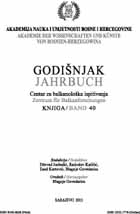Kraj bronzanog i početak željeznog doba na prostoru sjeverozapadne Bosne
End of the Bronze and begining of the Iron Age in Northeast Bosnia
Author(s): Orhan JamakovićSubject(s): Archaeology
Published by: Akademija Nauka i Umjetnosti Bosne i Hercegovine
Summary/Abstract: End of the Bronze and beginning of the Iron Age in the North West Bosnia is the process that lasted 6 centuries, from 1300 to 700 BC. At the beginning of this period area of North West Bosnia was inhabited by the Urnfield culture bearers. Their material culture showed that they composed same ethnic group with the ethnos from the area between rivers Sava, Drava and Danube. Entire population attached to this area represents just part of the master area defined by West Pannonia and East Alps. This area represents heart zone characterized in early Bronze age, and it is recognized in the later periods of Urnfield culture of other areas. This is reflected by the identity of cultural manifestations, firstly by the funerary rituals (incineration of deceased and depositing the ashes into urns covered with bowls), and also by the large number of pottery forms (bowls and biconical urns with buckled rims). On the other hand there are very strong impacts of the elements of Urnfield culture from the Baierdorf-Velatica cultural group on the material culture of the area between rivers and northwest Bosnia. Examples of decorative pins and typical ceramic forms imply to the origins and analogies with Central European Hugelgraber culture. Closest connections with our area we find in the cultural groups of Virovitica, Zagreb, Velika Gorica and Dalj. In the settlements of this phase we find very little information about production and products of metal. Lack of the tin and copper mines, as well as the finds of the moulds reveal that all metal objects were brought from the master area or that they have been imported. Certain finds, like Peschiera fibula from the Hrustovača cave and axes with wings in the middle (Blatna near Bosanski Novi, Babin potok and Barlovci near Banja Luka) allow connecting these finds with the absolute chronology of Central Europe. At the same time, we have to mention that production of Peschiera fibulas is related to the area between three rivers and Posavina. Fibula find from Hrustovača belongs to one of the oldest finds of this fibula type. All these findings could be determined in the late Mycenaean period III b, according to Arne Furmark to 1110, from 1300 to 1230 and 1230 to 1110 BC. They are analogously related with the finds from late Mycenaean settlements of Southern Greece, Thessaly, Boeotia and Macedonia. Despite the obvious content of the material culture which is related to West Pannonia and East Alpine region, some original elements start to appear only in our area. Those are mainly pins with fang on the head which originate from East Alpine and West Pannonia region. This type is known from the site of Donja Dolina. Large number of ceramic types and presence of ornamental manner of faceting and canalling are related to analogue types from the other sites of Unrfield culture. In our area some new original elements appear sporadically like bowls with indent and faceted rim.
Journal: Godišnjak Centra za balkanološka ispitivanja
- Issue Year: 2011
- Issue No: 40
- Page Range: 91-131
- Page Count: 41
- Language: Bosnian

